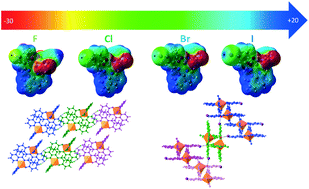Interplay of halogen and hydrogen bonding in a series of heteroleptic iron(iii) complexes†
Abstract
The influence of the halogen substituent on crystal packing and redox properties is investigated in a series of heteroleptic complexes [Fe(qsal-X)(dipic)]·MeOH (qsal-X = 4-halogen-2-[(8-quinolylimino)methyl]phenolate; dipic = 2,6-pyridinedicarboxylate; X = F 1, Cl 2, Br 3 and I 4). Compounds 1 and 2 exhibit triclinic symmetry (P![[1 with combining macron]](https://www.rsc.org/images/entities/char_0031_0304.gif) ), whereas 3 and 4 crystallise in monoclinic P21/n. The crystal packing shows self-sorting of the ligands with π-π interactions between the qsal-X ligands and overlap of the dipic ligands to form a 1D chain, that is supported by C–H⋯O interactions. In 1 and 2, the cross-section of the 1D chain is square, while for 3 and 4, it is rectangular. In the former, the dipic ligands interact through C
), whereas 3 and 4 crystallise in monoclinic P21/n. The crystal packing shows self-sorting of the ligands with π-π interactions between the qsal-X ligands and overlap of the dipic ligands to form a 1D chain, that is supported by C–H⋯O interactions. In 1 and 2, the cross-section of the 1D chain is square, while for 3 and 4, it is rectangular. In the former, the dipic ligands interact through C![[double bond, length as m-dash]](https://www.rsc.org/images/entities/char_e001.gif) O⋯π interactions, while π–π interactions are found in 3 and 4. Neighbouring chains are connected via π–π interactions involving the quinoline rings, but their relative position is driven by the preference of 1 and 2, for C–H⋯X interactions, whereas 3 and 4 form O⋯X halogen bonds. The nature and topology of the electron density of these interactions have been investigated using molecular electrostatic potential (MEP) mapping, quantum theory of atoms in molecules (QTAIM) and ‘non-covalent interactions’ (NCI) analysis. UV-visible experiments show LMCT bands associated with the qsal-X ligands, confirming the structure is stable in solution. Electrochemical studies reveal slight tuning of the Fe3+/Fe2+ redox couple showing a linear relationship between E°′ and the Hammett parameter σp.
O⋯π interactions, while π–π interactions are found in 3 and 4. Neighbouring chains are connected via π–π interactions involving the quinoline rings, but their relative position is driven by the preference of 1 and 2, for C–H⋯X interactions, whereas 3 and 4 form O⋯X halogen bonds. The nature and topology of the electron density of these interactions have been investigated using molecular electrostatic potential (MEP) mapping, quantum theory of atoms in molecules (QTAIM) and ‘non-covalent interactions’ (NCI) analysis. UV-visible experiments show LMCT bands associated with the qsal-X ligands, confirming the structure is stable in solution. Electrochemical studies reveal slight tuning of the Fe3+/Fe2+ redox couple showing a linear relationship between E°′ and the Hammett parameter σp.

- This article is part of the themed collections: Introducing the CrystEngComm Advisory Board and their research and Supramolecular & Polymorphism


 Please wait while we load your content...
Please wait while we load your content...